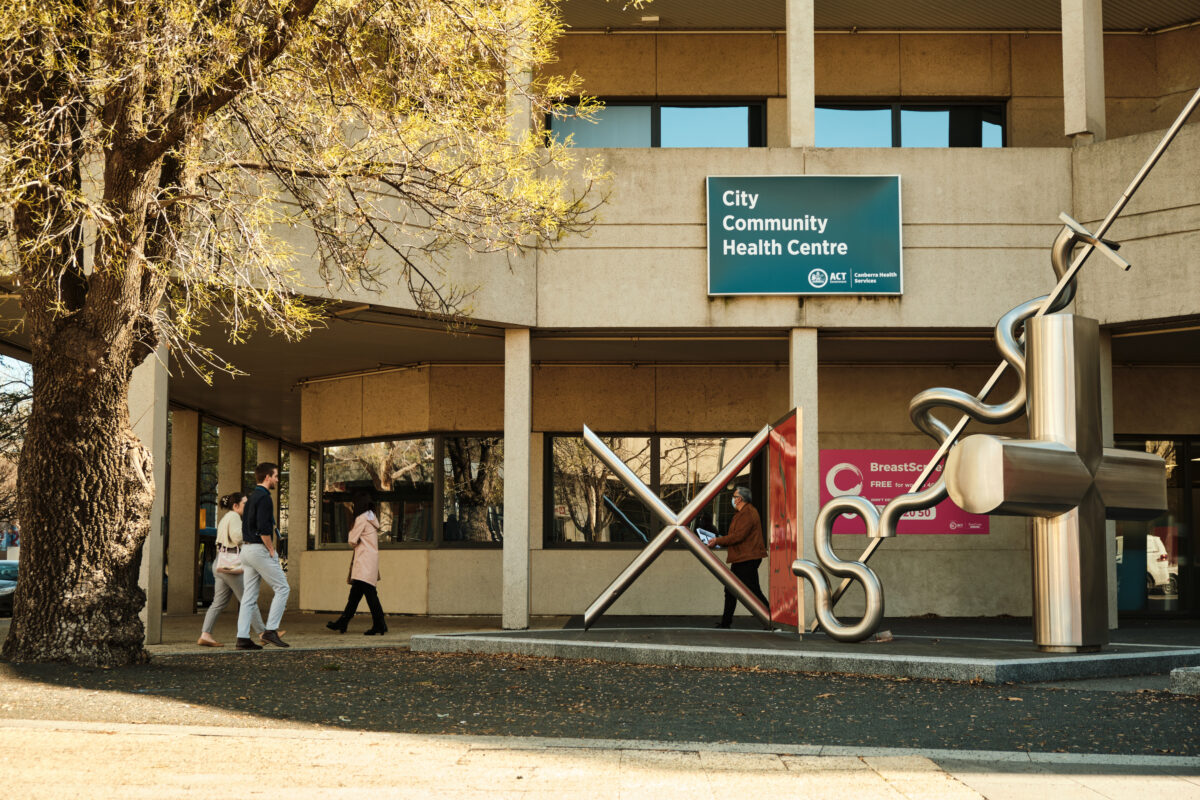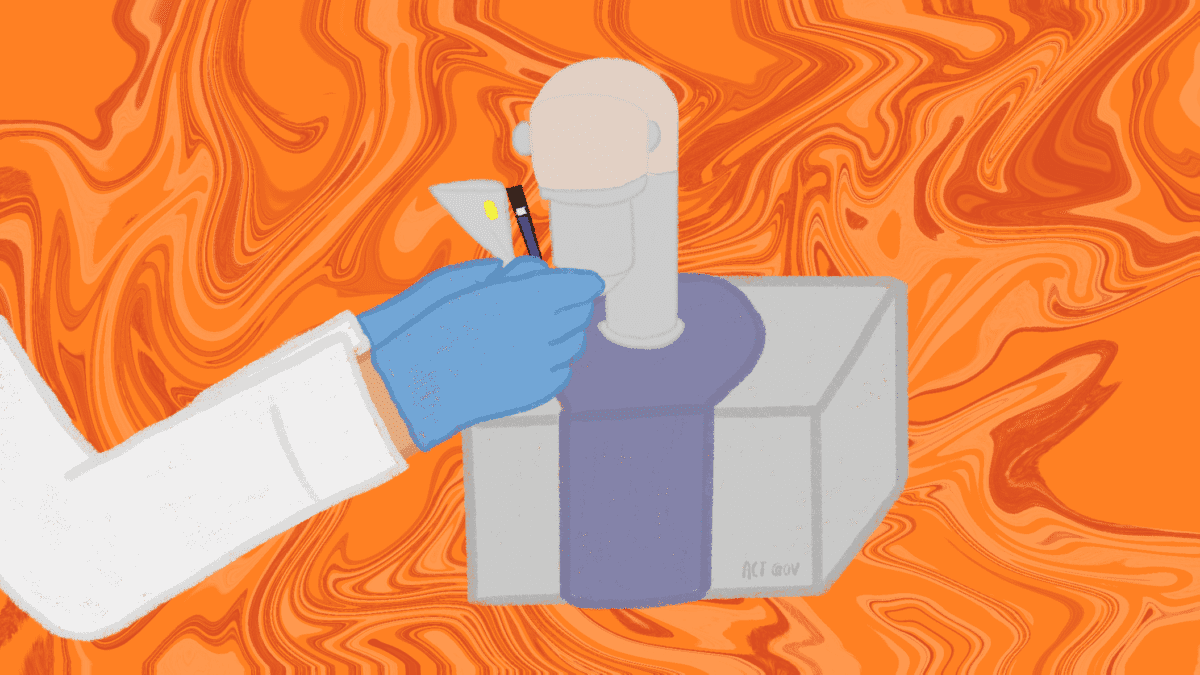Along leafy Alinga Street, innocuously located on the corner of the intersection between Moore Street and Rudd Street, history is being made. At this intersection, there is the Murray’s bus depot, where car-less Sydneysiders congregate to go home for the weekend. Across the road is an Australia Post office where Depopers send off vintage tees. A brown brutalist building with two giant medical-cross sculptures out the front marks the location of the ACT Community Health Centre.
Passers-by are unaware that inside this building is Australia’s first fixed-site drug testing facility, the CanTEST Health and Drug Checking Service. While the ACT government may be ready to trial the harm-reduction facility, another equally pressing question remains. Is Canberra prepared to accept that people are going to use this facility? More aptly – are Canberrans ready to accept that, to reduce harm truly, they must unlearn the judgments and stereotypes they hold about recreational drug users? To answer, let’s take a quick look at the ACT’s history as a trailblazer jurisdiction for pill testing.
In 2018, the Groovin the Moo (GTM) music festival hosted Australia’s first pill-testing facility. In its sophomore appearance the following year, experts hailed the program as a great success. 230 festival goers used the service, and several discarded drugs were found to contain chemicals linked to overdoses. Meanwhile, New South Wales experienced the dark summer of 2019, where six young people died of MDMA overdoses at music festivals. At the time, the NSW Coalition government urged young people not to do drugs. The ACT government used the harm-reduction evidence gathered from their GTM trial runs to draft a pill-testing policy. This policy led to the formation of the CanTEST Health and Drug Checking Service on Moore Street.

The free and confidential centre hosts a raft of counsellors, nurses, and drug experts to give patients the best information about their drug choices. However, along with all those staff, there is an elephant in the room: the stigma surrounding recreational drug use. In 2019 an Australian Institute of Health and Welfare report found that 70 percent of ACT citizens supported pill testing.
However, there is a significant difference between support for pill testing and societal acceptance of recreational drug use. The same 2019 report asked participants what penalty, if any, should apply to people found possessing drugs. 41 percent of North Canberrans supported referral to treatment or an education program for individuals who are found in possession of Ecstasy (MDMA). Yet, as discussed later, most MDMA users are recreational. Treating recreational users as people needing medical help seems like the hangover of a long-standing stigma around drug use. And this stigma has a long and continuing history of negative social harm.
There is a common sentiment among those who support pill testing but don’t condone recreational drug use: “They’re going to do it anyway, so they may as well be safe.” Embezzled in this sentiment is an underlying attitude you could call the concerned parent. This attitude says that while drugs should be tested, a certain level of judgment towards drug users should remain. Illicit activity should take place in the deepest crevices of private life and discussion thereof away from the workplace or family home. The concerned parent reinforces the felt stigma of drug users and prevents them from using services like CanTEST.
Imagine a young professional – the type that wears RM Williams and puffer vests and spends their Friday nights at PJ O’Reilly’s. The young professional wants to test a pill for an upcoming party. Yet, in the City Community Health Centre lobby, they see their supervisor. The odds of the young professional following through with testing their pill seem quite low.
Woroni surveyed a handful of students on their thoughts about the stigma surrounding recreational drug use.
One ANU third-year student was asked how they would feel running into their workplace supervisor outside the service said, “I would probably feel uncomfortable as this could impact how they view me within my workplace. I probably wouldn’t want to go….” Another ANU third-year student hit the head on the nail about why a supervisor might view their employee differently: “No, [I wouldn’t use the service] because of the stigma around taking illicit substances.”
Stigmas around drug use go hand-in-hand with stereotypes about those taking those drugs. Like most stereotypes, they are unrealistic because drug users are diverse. Of all Australians who had taken Ecstasy in 2019, 51 percent consumed the stimulant just once or twice. And while young people are the most likely group to take MDMA, overall consumption in Australia has increased due to more people in their 40s taking it. Educated, employed, and well-off people are, also, more likely to take MDMA. While it is equally as harmful to marginalise drug users who are not from these privileged groups, it is becoming increasingly more difficult to categorise people into negative stereotypes of drug users.
The stereotyping of drug users is no singular person’s fault. The War on Drugs has distorted our perception of the recreational drug user – and especially our parents’ perceptions:
“I feel comfortable talking about drugs with people my age; however, with people of my parent’s generation and older, I would have some hesitation.” said one ANU student.
The War on Drugs, as some commentators believe, was fuelled partly by the consumption of drugs in marginalised communities. American historian Peter Knight claims that the wariness of opium in the US became prevalent because of its association with Chinese immigrants in the 1870s. In the 80s, American drug sentencing laws treated a given quantity of crack cocaine as 100 times the equivalent of powdered cocaine. Yet, there is no evidence that crack cocaine is significantly stronger than powdered cocaine.
Rather, the disparity seemed to fall along racial lines. Crack cocaine was more common in African American communities than powdered cocaine in white communities. In 1986, the prison sentences for drug-related crimes for African Americans were 49 percent higher than for white Americans. With these laws, the target became not the drugs themselves but the racial identity of the people who took them.
Closer to home, it is no secret that drug use by First Nations people has been stigmatised in a way that does not apply to non-Indigenous people. Portrayals of Aboriginal drug use in the media are particularly harmful. One survey found that 74 percent of articles in 2012 from a selection of publications negatively depicted Aboriginal health issues, including drug use. The media helps fuel drinking and petrol sniffing stereotypes within Aboriginal communities. These stereotypes fuel racism and have catastrophic policy implications.
The Northern Territory Intervention stripped the rights of Aboriginal communities to autonomy with widespread alcohol bans. This, despite alcohol, being a legal drug and the alcohol ban only existing in Aboriginal communities. The Northern Territory Intervention was a clear example of how negative stereotypes of drug users can often be used as a tool for the subjugation of minority groups.
It should be no surprise then why some of the language used to describe drug users are derogatory. They lack nuance: the ‘clean/dirty’ divide, the ‘junkie/hippie’ stereotype, and the ‘party animal’ all paint a damning picture of drug use.
Yet the harm of stereotyping drug use does not have to be as severe as it has for marginalised groups for the stereotype to be still harmful. When we talk about pill testing, we mainly talk about the physical risk of harm involved in drug use. But Australians already know about these harms – drug education primarily revolves around the fact that substances can be dangerous.
According to one ANU student, support for pill testing in the ACT would exist “regardless of whether they [Canberrans] would use it, as it could negate harmful and deadly consumption of drugs.” Ironically, for safe-recreational drug users, the stigma around illicit activity has the potential to be their most harmful side-effect. For pill testing to be an effective harm reduction program, Australian society must change the discourse and stereotyping of drug use.
Withholding judgement for drug users does not mean that everyone must support drug consumption in the first place. It is valid to disagree with the concept of illicit substances and wish that others didn’t use them. However, there is a difference between disagreeing with someone else’s risk-taking decision and defining that person by that decision. Considering the social taboo around drug use across generations, we still define people who take drugs by that choice.
But sometimes, a progressive law or new institution can help bring society up to speed. For example, we have accepted the phasing out of many single-use plastics despite the idea sounding inconceivable merely a decade prior. If Canberrans can accept that, they can accept that some portion of the population takes drugs, wants to check to see if they are poisonous, and takes them if they’re not. They can also accept that there is no singular type of drug user and believing otherwise causes a different kind of social poison.
Perhaps one day, going to check a test on a pill at the ACT Community Health Centre will be as mundane as catching a bus to Sydney or going into the Australia Post. For now, the CanTEST Drug Checking Service is on trial, as are the people using the service. Hopefully, harm in both cases will be reduced.

We acknowledge the Ngunnawal and Ngambri people, who are the Traditional Custodians of the land on which Woroni, Woroni Radio and Woroni TV are created, edited, published, printed and distributed. We pay our respects to Elders past and present. We acknowledge that the name Woroni was taken from the Wadi Wadi Nation without permission, and we are striving to do better for future reconciliation.
